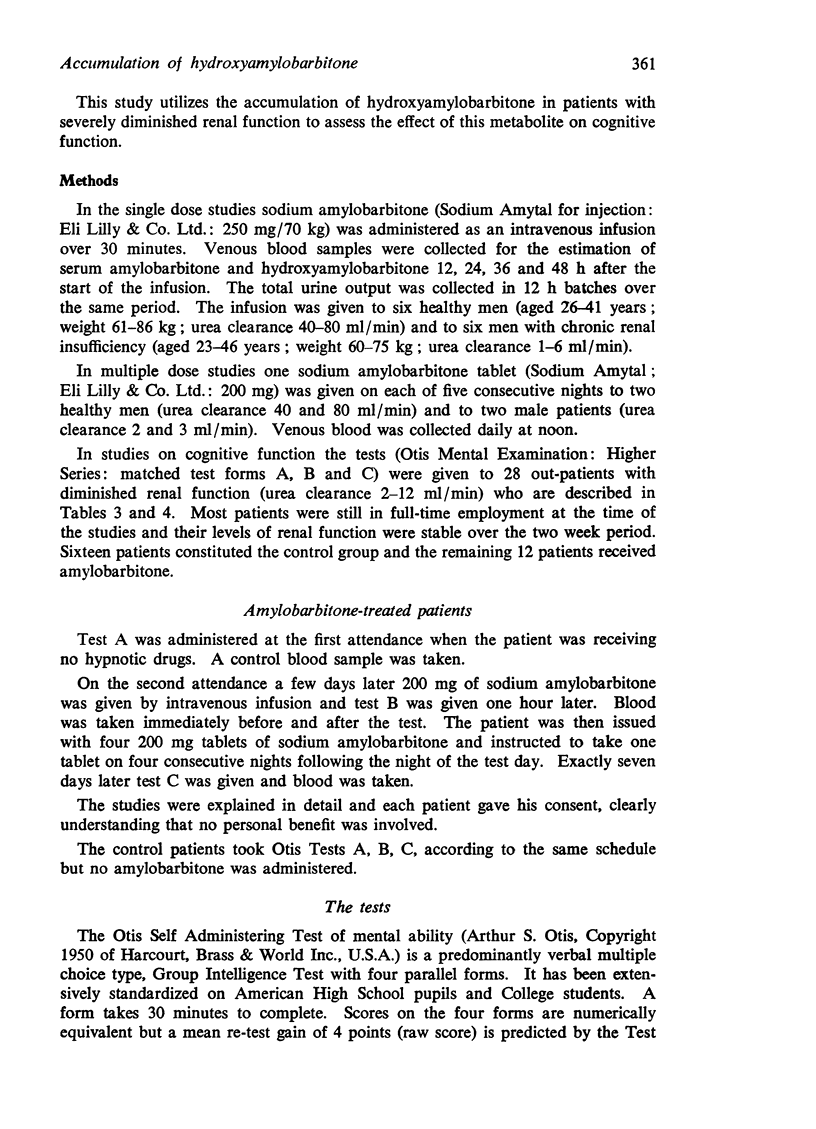Abstract
1. Sodium amylobarbitone was given by intravenous infusion to six patients with chronic renal insufficiency and to six healthy volunteer subjects. Serum concentrations of amylobarbitone and its major metabolite hydroxyamylobarbitone were measured by a gas chromatograph method.
2. The serum concentrations of amylobarbitone were consistently lower in the patient group than in the control group and the concentration half time was shorter (0·10>P>0·05); the 48 h urinary excretion of hydroxyamylobarbitone was reduced (P<0·001) and the serum concentrations of hydroxyamylobarbitone were consistently raised.
3. When two patients were given 200 mg of sodium amylobarbitone daily over five consecutive days the serum concentration of hydroxyamylobarbitone rose steadily to a maximum of about 8 μg/ml. The serum concentrations in two healthy control subjects did not exceed 0·5 μg/ml.
4. Three parallel tests of cognitive function (Otis matched test forms A, B and C) were given to 16 control patients and to 12 amylobarbitone-treated patients. Significant impairment of performance was observed in test B (P<0·001) at a time when amylobarbitone only could be detected in the patients' serum, and in test C (P<0·001) when amylobarbitone concentrations were very low (0·52±0·08 μg/ml±SEM) but hydroxyamylobarbitone concentrations were still high (3·30±1·23, μg/ml±SEM).
5. There was a strong (r=-0·71) and significant (P<0·01) negative correlation between the performance in test C and the serum concentration of hydroxyamylobarbitone. It is concluded that hydroxyamylobarbitone has cerebral depressant effects in man.
Full text
PDF







Selected References
These references are in PubMed. This may not be the complete list of references from this article.
- Balasubramaniam K., Lucas S. B., Mawer G. E., Simons P. J. The kinetics of amylobarbitone metabolism in healthy men and women. Br J Pharmacol. 1970 Jul;39(3):564–572. doi: 10.1111/j.1476-5381.1970.tb10364.x. [DOI] [PMC free article] [PubMed] [Google Scholar]
- Balasubramaniam K., Mawer G. E., Rodgers E. M. The estimation of amylobarbitone and hydroxyamylobarbitone in serum by gas liquid chromatography. Br J Pharmacol. 1969 Oct;37(2):546P–547P. [PMC free article] [PubMed] [Google Scholar]
- Grove J., Toseland P. A. The excretion of hydroxyamylobarbitone in man after oral administration of amylobarbitone and hydroxyamylobarbitone. J Pharm Pharmacol. 1971 Dec;23(12):936–940. doi: 10.1111/j.2042-7158.1971.tb09896.x. [DOI] [PubMed] [Google Scholar]
- Irrgang K. Zur Pharmakologie von 5-Aethyl-5-(3-hydroxyisoamyl)-barbitursäure, einem Stoffwechselprodukt der 5-Aethyl-5-isoamyl-barbitursäure. Arzneimittelforschung. 1965 Jun;15(6):688–691. [PubMed] [Google Scholar]
- Letteri J. M., Mellk H., Louis S., Kutt H., Durante P., Glazko A. Diphenylhydantoin metabolism in uremia. N Engl J Med. 1971 Sep 16;285(12):648–652. doi: 10.1056/NEJM197109162851202. [DOI] [PubMed] [Google Scholar]
- Mawer G. E., Miller N. E., Turnberg L. A. Metabolism of amylobarbitone in patients with chronic liver disease. Br J Pharmacol. 1972 Mar;44(3):549–560. doi: 10.1111/j.1476-5381.1972.tb07292.x. [DOI] [PMC free article] [PubMed] [Google Scholar]
- WADDELL W. J. THE METABOLIC FATE OF 5-ALLYL-5-(1-METHYLBUTYL)BARBITURIC ACID (SECOBARBITAL). J Pharmacol Exp Ther. 1965 Jul;149:23–28. [PubMed] [Google Scholar]
- Walker W. H. Simple ultrafiltration apparatus. J Clin Pathol. 1967 Sep;20(5):786–787. doi: 10.1136/jcp.20.5.786. [DOI] [PMC free article] [PubMed] [Google Scholar]


